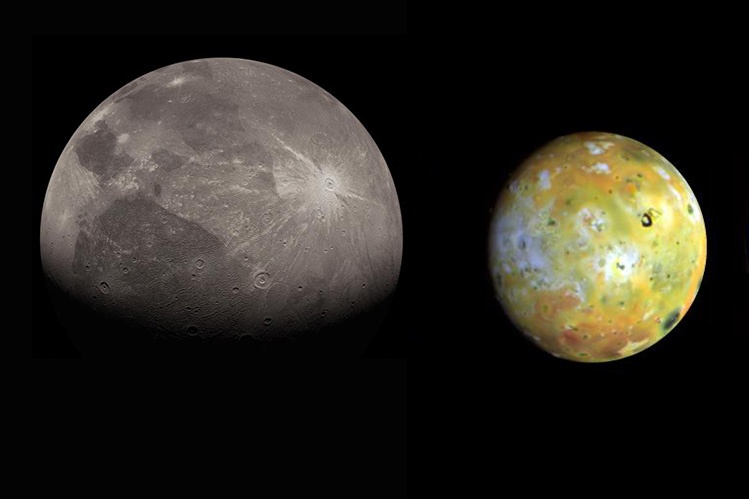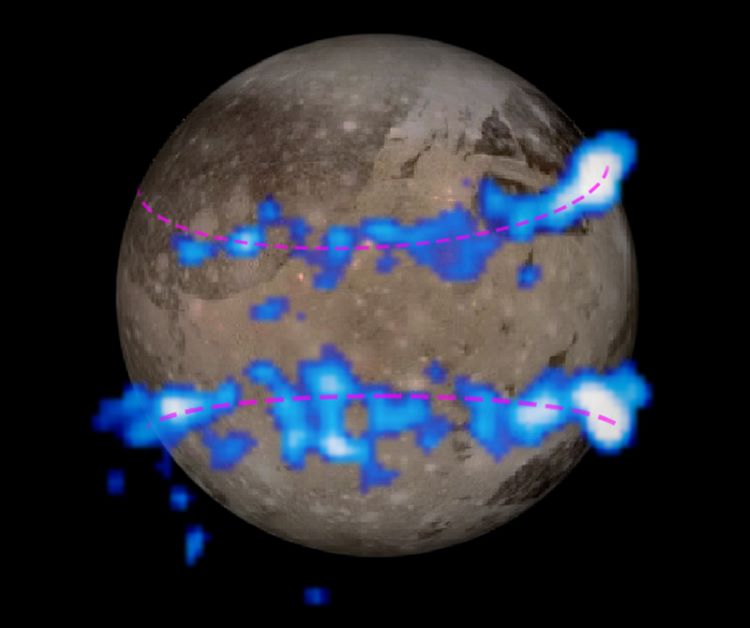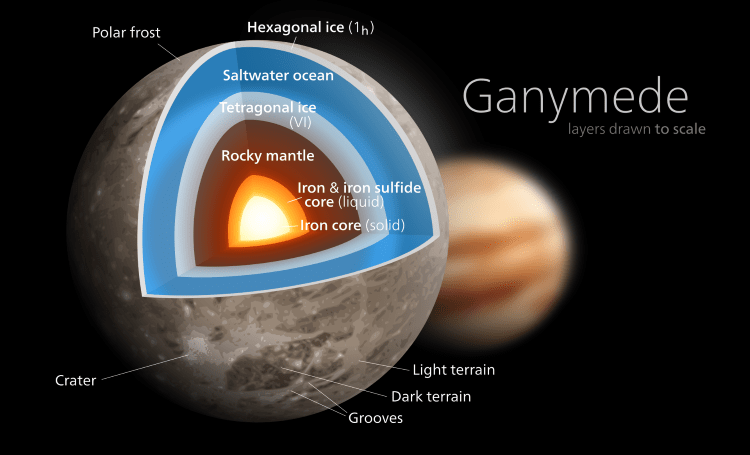A pair of studies published in JGR: Planets and Science Advances discuss new findings from NASA’s James Webb Space Telescope (JWST) regarding Jupiter’s first and third Galilean Moons, Io and Ganymede, and more specifically, how the massive Jupiter is influencing activity on these two small worlds. For Io, whose mass is about 21 percent larger than Earth’s Moon, the researchers made the first discovery of sulfur monoxide (SO) gas on the volcanically active moon. For Ganymede, which is the largest moon in the solar system and boasts twice the mass of the Earth’s Moon, the researchers made the first discovery of hydrogen peroxide, which exists in Ganymede’s polar regions.

“This shows that we can do incredible science with the James Webb Space Telescope on solar system objects, even if the object is really very bright, like Jupiter, but also when you look at very faint things next to Jupiter,” said Dr. Imke de Pater, who is a Professor Emeritus in the Department of Astronomy at the University of California, Berkeley, along with being lead author of the JGR: Planets paper discussing Io and a co-author on the Sciences Advances paper discussing Ganymede.
For Io, the researchers analyzed spectral data obtained with JWST’s Near-Infrared Spectrograph (NIRSpec) instrument when Io was orbiting in Jupiter’s shadow, which allowed the researchers to observe the glow from the active volcanoes that are across its surface. Through this, they successfully detected two known volcanoes on Io’s surface: Kanehekili Fluctus and Loki Patera, both of which exhibited active lava flows with minimum temperatures of 1200 Kelvin (926.85 degrees Celsius/1700 degrees Fahrenheit) with source vent sizes of about 0.25 km2 (0.09 mi2) and less than 0.1 km2 (0.03 mi2), respectively.

The greatest find was a first-time detection of SO gas connected to a volcanic eruption on Io, with this occurring at Kanehekili Fluctus. The team refers to this detection as a “forbidden SO emission line” due to SO’s difficulty to detect compared to sulfur dioxide (SO2), which is the dominant atmospheric component on Io. This emission line is very faint due to its low amounts combined with brief lifespan after having energy applied to it, also known as excitation. Additionally, SO can only be detected when Io is in Jupiter’s shadow, since this is when SO2 gas freezes onto Io’s surface, with only SO and recently erupted SO2 gas remaining in the atmosphere.
“These observations with Webb show for the first time that this excited SO actually did come from a volcano,” Dr. de Pater said.
Io is the most volcanically active planetary body in the solar system, exhibiting hundreds of volcanoes and many of which erupt lava dozens of kilometers (or miles) into space. This volcanic activity is caused by what’s known as tidal heating, which is when a large body exerts an enormous gravitational influence on a much smaller body, causing the smaller body to stretch and compress. Over time, this activity causes the smaller body’s interior to produce friction, which leads to interior heat.
In the case of Io, its mass is dwarfed by Jupiter, the latter of which is just over 300 times as massive as the Earth, which means Jupiter exerts an enormous gravitational influence on its tiny moon. Additionally, Io has a slightly eccentric orbit, meaning its orbit is just shy of being circular like the Earth’s. This means Io is closer to Jupiter at some points (known as perijove) in its orbit and farther away at other points (known as apojove) and is estimated to experience a distance difference of approximately 3,400 kilometers (2,113 miles) during one complete orbit.
This results in Jupiter’s massive gravity exhibiting a greater gravitational tug on Io at periapsis and a smaller tug at apoapsis, and this resulting interior heat on Io is why it’s the most volcanically active planetary body in the entire solar system. While the majority of the tidal heating occurring on Io comes from Jupiter’s gravity, Io is also constantly being tugged by Jupiter’s second Galilean Moon, Europa.
For Ganymede, the researchers also used JWST’s NIRSpec instrument to detect hydrogen peroxide (H2O2) at the polar regions of the large moon, which, like the SO detection on Io, is a first-of-its-kind discovery.
The researchers attribute the presence of hydrogen peroxide to a chemistry-based process known as radiolysis, which occurs when charged particles (also called ionizing radiation), strike water (or water ice), causing the water molecules to break apart. In the case of Ganymede, charged particles break apart the water ice in the moon’s polar regions and reconnect to form hydrogen peroxide. The reason why this occurs in the polar regions is due to Ganymede’s magnetic field, which interacts with Jupiter’s own massive magnetic field, and is currently the only known moon in our solar system to possess one.

“Just like how Earth’s magnetic field directs charged particles from the sun to the highest latitudes, causing the aurora, Ganymede’s magnetic field does the same thing to charged particles from Jupiter’s magnetosphere,” said Dr. Samantha Trumbo, who is a 51 Pegasi b Postdoctoral Fellow at Cornell University, along with being lead author of the Sciences Advances paper discussing Ganymede and a co-author on the JGR: Planets paper discussing Io. “Not only do these particles result in aurorae at Ganymede, as well, but they also impact the icy surface.”

When Dr. Trumbo was a PhD student at Caltech, she studied hydrogen peroxide on Europa with Caltech professor of planetary astronomy, Dr. Michael Brown. Unlike Ganymede, where hydrogen peroxide is found to be limited to the polar regions, Europa was found to possess hydrogen peroxide throughout its surface, likely due to the lack of a magnetic field shielding the surface from the charged particles emanating from Jupiter.
“This is likely a really important and widespread process,” said Dr. Trumbo. “These observations of Ganymede provide a key window to understand how such water radiolysis might drive chemistry on icy bodies throughout the outer solar system, including on neighboring Europa and Callisto (the fourth Galilean moon).”
Like Io, Ganymede has been found to also experience tidal heating from Europa orbiting inward and Callisto orbiting outward, making it a strong candidate for containing a liquid ocean beneath its icy crust. But, how does Ganymede have a magnetic field? This is due to planetary differentiation, meaning its interior contains separated layers of chemical elements, with the heavier elements sinking deeper into the moon. This also means it contains a metallic core like the Earth, and it is this metallic core that produces the moon’s magnetic field.

What new discoveries will researchers make about Io’s sulfur gas and Ganymede’s hydrogen peroxide poles in the coming years and decades? Only time will tell, and this is why we science!
As always, keep doing science & keep looking up!

